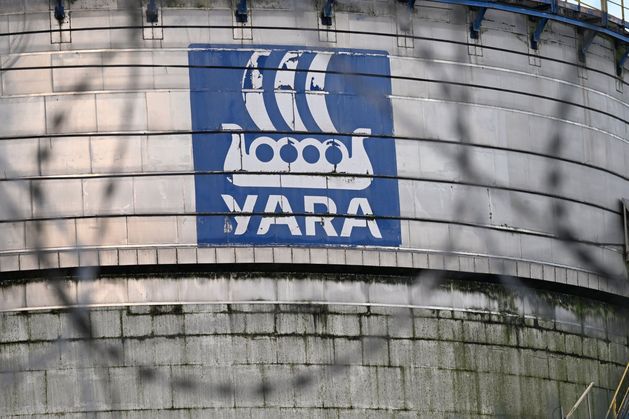


A logo of the chemical fertilizer maker Yara at the entrance of the plant in Montoirde-Bretagne, western France. (Photo by DAMIEN MEYER / AFP) (Photo by DAMIEN MEYER/AFP via Getty Images)
Europe’s largest fertiliser maker, Yara International ASA, opened a renewable hydrogen plant in Norway as it seeks to decarbonize a process that uses natural gas as a feedstock.
The fertiliser industry faces a tough task to cut emissions, as gas is both a feedstock and a source of energy in the production of ammonia. So-called green ammonia can be produced by combining hydrogen from water electrolysis using renewable energy with nitrogen.
The 24-megawatt demonstration facility, currently Europe’s largest water electrolysis plant, is a step toward cutting emissions at the Heroya factory, one of Norway’s largest sources of CO2 outside the oil and gas industry. The new facility will cut Heroya’s 800,000 tons of annual CO2 emissions by 5%.
“Renewable ammonia is an important part of the decarbonization puzzle, however developing it at scale takes time,” Yara Clean Ammonia Chief Executive Officer Hans Olav Raen said in a statement on Monday.
The new facility, being inaugurated by Norwegian Prime Minister Jonas Gahr Store in Porsgrunn in the Telemark region, has already delivered the first fertilizer made from renewable ammonia produced at the plant.
Yara, which invented a process to mass produce fertiliser more than a century ago, wants to become a major player in supplying clean energy. It sees clean ammonia as a solution to decarbonizing challenging sectors, such as shipping, power generation and agriculture.
Yara operates the world’s largest ammonia network, with 15 ships and access to 18 terminals, plus multiple production and consumption sites. The company’s position as a consumer and trader of ammonia may help cut the risk of hydrogen projects when it comes to offtake agreements for the gas.
Yara has also signed an agreement with the Northern Lights project to transport CO2 from its Sluiskil site in the Netherlands to be stored under the Norwegian North Sea. It’s also considering carbon capture projects in the US.
Bloomberg .